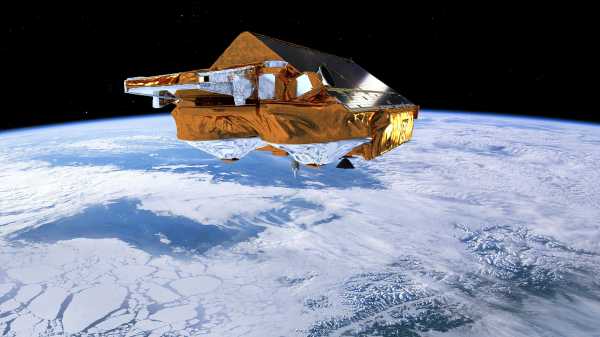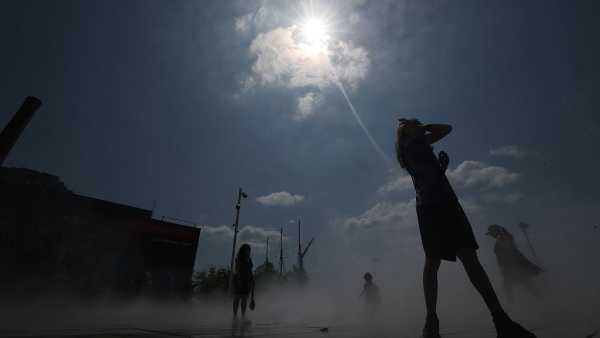
The European Space Agency's Cryosat-2 satellite is monitoring subtle changes in ice sheet thickness in Antarctica and Greenland. (Image credit: ESA/AOES Medialab)
Scientists, using satellite data collected over a decade, have discovered 85 previously unknown lakes hidden beneath the Antarctic ice.
The researchers stated that the newly discovered lakes are “active,” meaning they periodically dry up and fill, changing size and shape over months and years. This subglacial activity affects the stability of glaciers and their movement across Antarctic bedrock, which, in turn, could affect global sea levels, the researchers noted.
You may like
-

Scientists have discovered long-lost giant rivers that flowed through Antarctica up to 80 million years ago.
-

'It was so unexpected': 90 billion litres of meltwater pierced the Greenland ice sheet in an unprecedented melt
-

Antarctic sea ice collapse linked to mysterious surge in ocean salt levels
Prior to this latest discovery, 146 active subglacial lakes were already known in Antarctica. The new study brings the total number of active lakes to 231 and expands scientists' understanding of when and how subglacial lakes drain and refill, said lead author Sally Wilson.
“Monitoring the filling and draining of subglacial lakes is incredibly challenging,” said Wilson, a doctoral student at the University of Leeds's Institute of Climate and Atmospheric Science. “Before our study, only 36 complete cycles—from the beginning of filling to the end of draining—had been recorded worldwide. We recorded another 12 complete filling and draining cycles, bringing the total to 48.”
Subglacial lakes are accumulations of meltwater that form when geothermal heat from the Earth's interior rises to the base of an ice sheet or when sufficient heat is generated by friction between ice and bedrock. Subglacial lakes can occasionally dry out periodically, creating a flow of water that lubricates the bottom of the ice sheet and facilitates its sliding over bedrock, accelerating the ice's movement toward the ocean.
For the study, the scientists analyzed data collected between 2010 and 2020 by the European Space Agency's Cryosat-2 satellite, which measures changes in the thickness of sea ice, glaciers, and ice sheets worldwide. Cryosat-2 is equipped with an instrument called a radar altimeter, which can detect small changes in the elevation of ice formations, including changes caused by runoff and the filling of lakes at the base of the ice.
The data revealed dozens of locations where the Antarctic ice sheet alternately sinks and rises slightly as meltwater drains and recharges subglacial lakes. The observations also revealed 25 lake groups and five previously unobserved subglacial lake networks with interconnected drainage and recharge cycles, the researchers wrote in a study published September 19 in the journal Nature Communications.

A map of Antarctica showing the locations of 85 recently discovered “active” subglacial lakes (red triangles). The pink area is where Cryosat-2 collected data between 2010 and 2020.
The results are important because they expand scientists' understanding of ice sheet dynamics and their impact on global sea levels, which could help researchers develop more accurate climate and Earth models. “The numerical models we currently use to predict the contribution of all ice sheets to sea level rise do not account for subglacial hydrology,” Wilson said. “These new datasets on the locations of subglacial lakes, their extent, and time series of changes will be used to deepen our understanding of the processes that control water flows beneath Antarctica.”
RELATED STORIES
Scientists have peered into a secret Antarctic lake hidden beneath the ice and discovered a previously unseen ecosystem.
Scientists have discovered a hidden “system” that is driving the Antarctic ice sheet into the ocean.
“We were completely baffled”: Antarctica is behaving in ways we've never seen before. Will it recover?
Some subglacial lakes in Antarctica are stable, meaning they neither dry up nor refill. An example is Lake Vostok, located beneath the East Antarctic Ice Sheet and reportedly holding more than enough water to fill the Grand Canyon. Researchers have noted that if Lake Vostok were to ever dry up, it could impact the entire ice sheet and lead to sea level rise.
“The better we understand the complex processes affecting the Antarctic Ice Sheet, including the meltwater flow at its base, the more accurately we can predict the extent of future sea level rise,” concluded Martin Wearing, a digital Earth twin specialist and coordinator of ESA's Polar Science Cluster, in a statement.
Antarctica Quiz: Test Your Knowledge of Earth's Frozen Continent TOPICS European Space Agency

Sasha Pare, Social Link Navigation, Staff Writer
Sasha is a staff writer for Live Science based in the UK. She holds a BA in Biology from the University of Southampton in England and an MA in Science Communication from Imperial College London. Her work has appeared in The Guardian and on the health website Zoe. Besides writing, she enjoys playing tennis, baking bread, and browsing thrift stores.
You must verify your public display name before commenting.
Please log out and log back in. You will then be asked to enter a display name.
Exit Read more

Scientists have discovered long-lost giant rivers that flowed through Antarctica up to 80 million years ago.

'It was so unexpected': 90 billion litres of meltwater pierced the Greenland ice sheet in an unprecedented melt

Antarctic sea ice collapse linked to mysterious surge in ocean salt levels

Drastic changes happening in Antarctica will 'affect the world for generations to come'

A study has found that melting glaciers could trigger volcanic eruptions around the world.

The 40-year-old “queen of icebergs” A23a is no longer the world's largest, having lost several “very large chunks” since May.
Latest news from Antarctica

The 40-year-old “queen of icebergs” A23a is no longer the world's largest, having lost several “very large chunks” since May.

Drastic changes happening in Antarctica will 'affect the world for generations to come'

Scientists have discovered long-lost giant rivers that flowed through Antarctica up to 80 million years ago.

Antarctic sea ice collapse linked to mysterious surge in ocean salt levels

The world's largest iceberg, A23a, is breaking up into thousands of pieces near a penguin refuge.

NASA satellites show that Antarctica is covered in ice despite rising global temperatures. How is this possible?
Latest news

Scientists have discovered 85 “active” lakes buried beneath Antarctic ice.

A new study has revealed that a seven-year-old Mayan child had a green jade “tooth tartar”

City-killer asteroid could be destroyed by nuclear explosion before it approaches the Moon

'Serious threat': China braces for the approach of Super Typhoon Ragas, the strongest storm this year, with winds reaching 180 km/h.

A rare blue-green hybrid jay spotted in Texas is a descendant of birds whose lineages diverged 7 million years ago.

A giant dinosaur with “brushcutter-like claws” and a crocodile leg still in its mouth has been found in Argentina.
LATEST ARTICLES

1The danger of declining US birth rates is “greatly exaggerated,” experts say.
Live Science magazine is part of Future US Inc., an international media group and leading digital publisher. Visit our corporate website.
- About Us
- Contact Future experts
- Terms and Conditions
- Privacy Policy
- Cookie Policy
- Accessibility Statement
- Advertise with us
- Web notifications
- Career
- Editorial standards
- How to present history to us
© Future US, Inc. Full 7th Floor, 130 West 42nd Street, New York, NY 10036.
var dfp_config = { “site_platform”: “vanilla”, “keywords”: “type-news-daily,serversidehawk,videoarticle,van-enable-adviser-
Sourse: www.livescience.com





